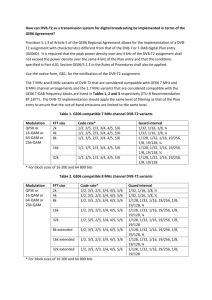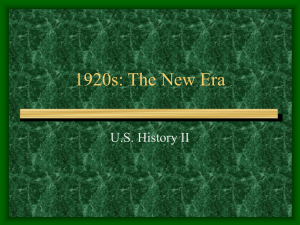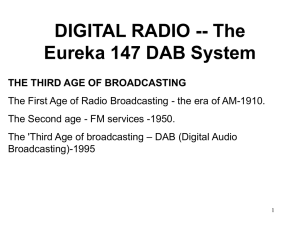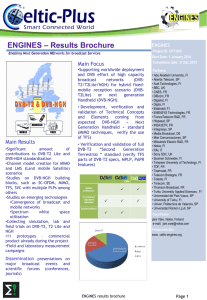DVB-T2_Narrowband
advertisement
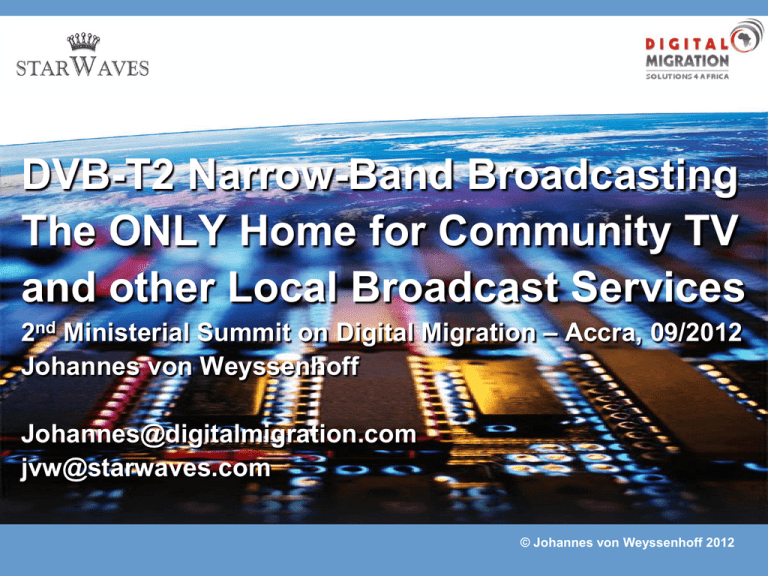
DVB-T2 Narrow-Band Broadcasting The ONLY Home for Community TV and other Local Broadcast Services 2nd Ministerial Summit on Digital Migration – Accra, 09/2012 Johannes von Weyssenhoff Johannes@digitalmigration.com jvw@starwaves.com © Johannes von Weyssenhoff 2012 Page 2 Community Broadcasting and its Relevance to Creation and Distribution of Local Content In post-colonialism Africa the preservation of African customs and heritage is an essential responsibility of every African nation. The media industry is playing a key role within this responsibility. Whereas mainstream media often struggle to fulfil this requirement as they often have to maintain business objectives by matching with more demand on popular international content, especially community broadcasting has been identified as a core distribution channel as well as source of real local content. As heritage is generally preserved within communities at a higher focus than in urban regions where people merely just share space because of economic than cultural reasons, it is visible that African governments are promoting the relevance of community broadcasting as one of the key elements of media. The production of local content does, can and will happen within the communities where local African spirit is still alive. © Johannes von Weyssenhoff 2012 Page 3 Community Broadcasting and its Relevance to Communication within the Municipalities Recently South Africa has experienced the disappointment of some of its citizens claiming the lack of service delivery in the municipalities. Often it is not even the government failing to deliver – rather it turns out that there is a factor of missing communication to inform the citizens of actions taken and planned to avoid such clashes. This needs to happen on all three tiers: on national, regional and local basis. The Public Broadcaster (e.g. in South Africa SABC) has national obligations and is neither fitted nor mandated to provide community or municipality broadcasting In DTT, the countries which have adopted DVB-T2 have not yet developed a strategy for distributing local television broadcasting. Local broadcasting automatically is interactive (without the necessarity of a dedicated interactive technology) as citizens are more personally involved, which enables a two-way communication at a natural level. © Johannes von Weyssenhoff 2012 Page 4 Community Broadcasting and its Demand At the end of the chain of any media production is the publication; without publication there will be no motivation to continue the production. This is the reason why community broadcasting must be on air to ensure the continuation of local content production. Also it is essential that broadcasting happens on a municipality level to avoid lacks of communication. There is a requirement on local/community broadcasting that needs to be catered for in the broadcasting plan, especially at this point of the digital migration of broadcasting where all the spectrum and other ressources are new defined. The current regulatory and policy strategy of utilizing the given technology does not cater for this demand. This presentation will discover a fantastic opportunity within the given new technology to cater for this demand, it only needs to be enabled! © Johannes von Weyssenhoff 2012 Page 5 Spectrum Used for Terrestrial Broadcasting © Johannes von Weyssenhoff 2012 Frequencies Overview (Southern Africa) These are the Frequencies available for Digital Terrestrial Television Broadcasting on DVB-T2: VHF Band I: 47 – 68 MHz (7 MHz bandwidth)* VHF Band III: 174 - 254 MHz (8 MHz bandwidth) VHF Band III**: 174 - 240 MHz (1.7MHz (Narrow Band) b/w)** UHF Band IV, V: 470 - 861 MHz (8 MHz bandwidth) L-Band: 1.452 - 1.492 GHz (1.7 MHz (Narrow Band) b/w) * Band actually not in use for broadcasting, but should be considered to be used in large SFN’s in South Africa’s Northern Cape as it can exist in the SKA area (<70MHz)! ** Proposed use for DAB only 11A-12D after analogue TV switch off. Extension to 254MHz for T2 to be considered. Currently 3 frequencies below and above 243MHz are available for immediate use! By the way, 2 nation-wide SFN’s on two of those narrowband VHF frequencies can replicate all existing analogue broadcasting that is currently on VHF. Page 6 © Johannes von Weyssenhoff 2012 Page 7 Digital Transmission – Recap The very beginning of the commercial use of digital media was the audio CD in 1982. At this time, digital audio was uncompressed and required a data rate of 1.41Mbps whilst data transmission on telephone lines with modems just came by 1.2kbps – more than 1000 times slow! The break even between possible transmission data rate and efficiency of data compression allowed the introduction of DAB 1995, followed by DVB-T 1997, DVB-H 2004, T-DMB 2006 and finally DVB-T2 in 2008. If you look at the development of electronic processing power, which is required for high performing data compression, it is obvious that a newer digital broadcast standard always will be by far more efficient than the one it has superseded. © Johannes von Weyssenhoff 2012 Page 8 Gain of Spectrum Efficiency towards DVB-T2 Looking at the efficiency gain within the development of Digital Video Broadcasting, we can see the improvement on the bandwidth of an analogue TV channel: Analogue TV: 1 Channel 7/8 MHz 10 = 1 TV Program DVB-T MPEG 2: 1 Channel 7/8 MHz 10 = 4-5 SD TV Programs DVB-T MPEG-4: 1 Channel 7/8 MHz 10 = 8-10 SD TV Programs DVB-T2 MPEG-4: 1 Channel 7/8 MHz 10 = 15-20 SD TV Programs! © Johannes von Weyssenhoff 2012 Multiplex Dilemma Consequently, the multiplex within the allocated bandwidth will cater for more and more channels, but this is not only an advantage: Large Multiplexes with 15+ channels are perfectly suitable for multichannel content providers with identical footprint for all channels Even a share of such a multiplex between two main operators can probably be managed due to Multi-PLP functionality if necessary Including small content providers such as Community TV stations with an individual footprint into such large multiplex is in some cases impossible The operator of the main multiplex may be confronted with extra unwanted administration efforts and/or financial implications The small content provider (e.g. community TV station) may not be able to cater for financial requirements of the main mux operator => A separation of small / local TV stations is a major requirement. Page 9 © Johannes von Weyssenhoff 2012 Restrictions coming with Digitization In the analogue world, any individually required coverage could be achieved by just placing a transmitter into the centre of the desired footprint and adjusted by output power and antenna pattern. This natural and simple method can be applied easily and is also used for community broadcasting; but it cannot be translated into the DTT standard in its current rollout plan. The spectrum efficiency discussion has now emerged with DVB-T2. The DoC has identified the desperate demand to cater for community broadcasting as reflected in their digital broadcast policy but a technical solution has not been associated yet. Page 10 © Johannes von Weyssenhoff 2012 DVB-T Spectrum vs. DVB-T2 Spectrum Naturally the DVB Consortium was fully aware of this dilemma and therefore included new bandwidth modes into the DVB-T2 standard: Additionally to 6, 7 and 8 MHz (projecting the different current analogue TV channels around the world in VHF and UHF) three new bandwidth modes have been introduced, including 1.7MHz (Narrow Band). So in fact DVB-T2 provides a solution to exactly this problem: It caters for the creation of narrow multiplexes with ¼ bandwidth of a “full” mux: DVB-T2 MPEG-4: 1 Channel 7/8 MHz 15-20 SD TV Programs + Radio 10 DVB-T2 MPEG-4: 4 Channels 1.7MHz Each 1-3 SD TV Programs + Radio 10A Page 11 10B 10C 10D © Johannes von Weyssenhoff 2012 Spectrum for Narrowband Broadcasting The spectrum for Narrow Band broadcasting, as used for T-DAB, is: VHF-Band III, each VHF channel (Europe: Ch. 5-13) is split into 4 sub channels, e.g. Channel 11 will be divided into 11A, 11B, 11C, 11D L-Band (1,452-1,490MHz), Channels LA, LB, LC … LW Both the bands are regulated broadcast bands in South Africa Whilst VHF Band III is still excessively used by analogue television transmissions the L-Band is currently completely vacant L-Band frequencies have a smaller coverage area (approx. 25km) Larger footprints can be created with single frequency networks => Narrow Band Broadcasting has been included into the standard for exactly this purpose and is the only viable solution for community TV and other special TV services that require an individual footprint outside the big multiplexes. Page 12 © Johannes von Weyssenhoff 2012 Spectrum Efficiency DVB-T2 vs DAB+ If necessary, the existing T-DAB spectrum allocations can be shared between DAB+/DMB and DVB-T2, but also it should be considered that DVB-T2 is 3.5 times more spectrum efficient to DAB based broadcast standards. For sound and mobile TV broadcasting the new “DVB-T2 lite” profile has been published recently with Narrowband tests currently undertaken in Denmark. Details can be found here: http://www.digitalradiotech.co.uk/documents/dvb-t2_vs_dab+.htm http://dvb.org/news_events/news/new-dvb-t2-profile-t2-lit/index.xml Page 13 © Johannes von Weyssenhoff 2012 Total Citizen Empowerment Using DVB-T2 in the Narrow Band would provide: Optimal conditions for community TV / Radio stations – no need to share unwanted or not compliant footprint with the big multiplex operators Precise SFN’s can be designed even to match small or special footprint areas Low cost and independent operation can empower a small media business to grow without taking disadvantages Radio services can also be implemented easily Provision of a regionally limited platform for testing purposes >> Job creation in the media industry >> Support towards generation of local content >> Preservation of cultural heritage >> Information delivery within the municipalities And MUCH MORE!!!!!! Page 14 © Johannes von Weyssenhoff 2012 Virtual Classroom of their OWN School! Page 15 © Johannes von Weyssenhoff 2012 Few little Steps to Enable the Great Improvement The implementation of the Narrow Band into the standard DVB-T2 profile will require the following immediate actions: The reception of the L-Band spectrum as well as the decoding of 1.7MHz Bandwidth must be reflected as an amendment in the DTT Minimum Receiver Requirements at least as an option. This is only a small alignment as the 1.7MHz profile is based on the NorDig DVB-T2 specifications and L-Band frequencies are identical with T-DAB. Also the required frontend-chipsets are widely available (currently used for DAB) The current STB tender process should be amended to encourage manufactures to implement. Even if not all STB’s may support it, the consumer who has a demand on community TV will have a choice. Receiver antennas must be able to pick up the L-Band. This can be realized by integrating the L-Band antenna onto the STB PCB (zero cost!) and if required a combined multiband antenna as add-on. Page 16 © Johannes von Weyssenhoff 2012 Next Steps Engage appropriate consulting on the matter SABS to prepare Set-Top-Box specification process for changes immediately (as indicated, it can be optional) ICASA to integrate Narrowband into DTT Regulations Invite the industry to undertake a quick pilot to verify feasibility and propagation predictions, perhaps in liaison with Denmark where similar tests are already ongoing Implement Narrowband profile into Set-Top-Box specifications Publish amended DTT regulations which will no longer suffer from the community broadcasting dilemma! Once all of some 100,000 receivers without these options are out there in the market, it will be difficult to rescue community broadcasting! Page 17 © Johannes von Weyssenhoff 2012 Conclusion Page 18 SADC is the world’s first region to replace analogue television broadcasting with DVB-T2. Ignoring the responsibility to look at all aspects of the new standard would be a fatal mistake which can hardly be corrected once millions of subsidized receivers are distributed in the market. Incorporating Narrow-Band into DTT will be the major improvement that digital broadcasting can deliver to us showing the world our innovative capability to perform. Furthermore, Narrow-Band DTT receivers, as well as broadcast equipment will be trendsetting products that can be exported to other markets in Africa and the world. © Johannes von Weyssenhoff 2012

